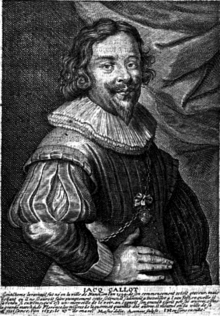From Wikipedia, the free encyclopedia
Jacques Callot (French: [ʒak kalo]; c.1592 –[citation needed]) was a baroque printmaker anddraftsman from the Duchy of Lorraine[1] (an independent state on the north-eastern border of France, southwestern border of Germany and overlapping the southern Netherlands). He is an important person in the development of the old master print. He made more than 1,400 etchingsthat chronicled the life of his period, featuring soldiers, clowns, drunkards, Gypsies, beggars, as well as court life. He also etched many religious and military images, and many prints featured extensive landscapes in their background.
Contents
[hide]Life and training[edit]
Callot was born and died in Nancy, the capital of Lorraine, now in France. He came from an important family (his father was master of ceremonies at the court of the Duke), and he often describes himself as having noble status in the inscriptions to his prints. At the age of fifteen he was apprenticed to a goldsmith, but soon afterward travelled to Rome where he learnedengraving from an expatriate Frenchman, Philippe Thomassin. He probably then studied etchingwith Antonio Tempesta in Florence, where he lived from 1612 to 1621. More than 2,000 preparatory drawings and studies for prints survive, but no paintings by him are known, and he probably never trained as a painter.
The Metropolitan Museum of Art, New York
This boldly-worked sheet is a study for an etching depicting a May Day celebration in a village recently identified as Xeuilley, a small town in Lorraine where Callot’s family owned property.
Featured Artwork of the Day: Jacques Callot (French, 1592–1635) | May Day Celebrations at Xeuilley | ca. 1624-25http://met.org/1zuMBoT

This boldly-worked sheet is a study for an etching depicting a May Day celebration in a village recently identified as Xeuilley, a small town in Lorraine where Callot’s family owned property.
Featured Artwork of the Day: Jacques Callot (French, 1592–1635) | May Day Celebrations at Xeuilley | ca. 1624-25http://met.org/1zuMBoT









沒有留言:
張貼留言